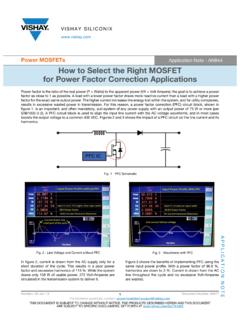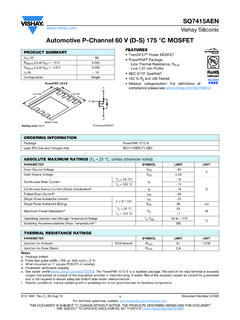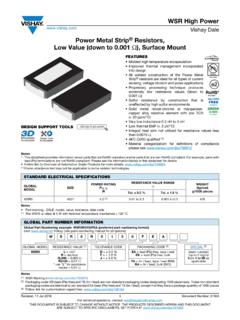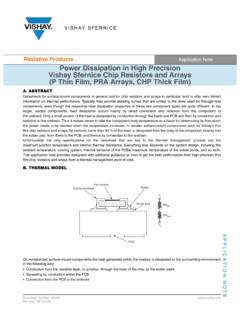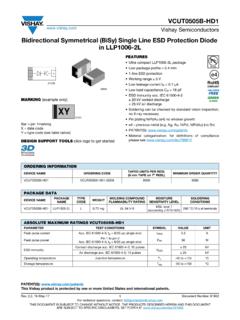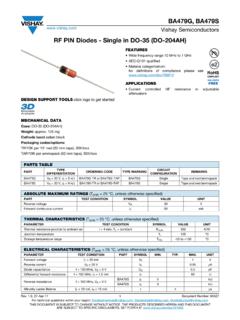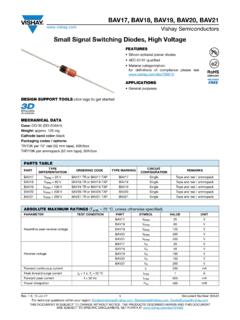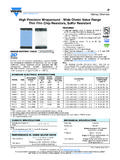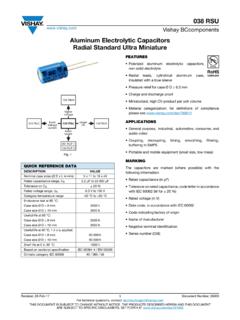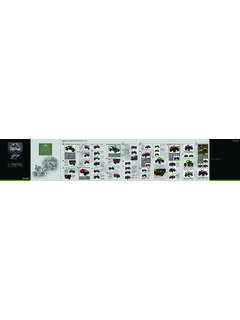Transcription of High-Voltage Silicon MOSFETs, GaN, and SiC: All have a place
1 High-Voltage Silicon mosfets , GaN, andSiC: All have a placePhilip Zuk, Director of Market Development, High-Voltage MOSFET Group, Vishay Siliconix- June 20, 2012 Questions have arisen about how Silicon will compete against wide bandgap (WBG) materials such asSilicon Carbide (SiC) and Gallium Nitride (GaN). There are many different technologies used in highvoltage Silicon devices today and though Si mosfets and WBG technologies will be the focus of thisarticle, IGBTs are reviewed as they are a competing technology within the high voltage market. TheMOSFET, IGBT, and JFET (WBG) technologies breakdown as follows.
2 mosfets (Si)Conventional planar technologylSuperjunction technologylIGBTs (Si)Non-punch through (NPT) technologylPunch through (PT) technologylField stop (FS) technologylMOSFETs (SiC)Conventional planar structurelJFETS (GaN)Normally ON lNormally OFF lThere is a lot of interest in the WBG technologies such as SiC and GaN and the purpose here is toshow that both Si and WBG materials (SiC and GaN) all have their place within the power industryand neither will completely displace each power MOSFET market in 2010 was $ with an expected growth of to $ in2015. Silicon conventional planar devices range from voltages under 100V to greater than 1000V,with superjunction ranging from 500V thru 900V and IGBTs from 600V and up to and including1200V (for this discussion).
3 This paper defines that equal to and greater than 400V are classified as high voltage devices. The400V and greater voltage mosfets are the fastest growing segment out of all mosfets . In 2011this segment represented $ growing at a CAGR of over the next five years[1]. Out ofthis $ , superjunction devices account for around $500M growing close to $1B by 2016[2]. Today, much of the demand in superjunction devices is in the 500V to 650V range with a smallerportion in 800V and 900V. That being said just over $ is represented by conventional planardevices with the largest market segments being computer, office equipment, and consumer.
4 Though IGBTs represent just under a billion dollars (less than 600V to greater than 900V) of thehigh- voltage device market they have been the fastest growing since the beginning of 2010. Acouple reasons for this growth were the demand for solar inverters and a redesign in white goodswhere China has enacted a five year plan to reduce energy one compares the two Si MOSFET technologies (superjunction and conventional planar) and SiIGBTs based on a similar die size this is what you would see:Superjunction (performance driven) Lower conduction losses: ability to reduce on-resistance four times over a similarvoltage conventional planar.
5 Lower switching losses: based on the same on-resistance, the ability to reduceswitching characteristics such as QGD and reverse transfer capacitance (Crss)Conventional Planar (value driven)- Based on the same on-resistance of a superjunction device:o Greater robustness: due to the larger die size, therefore better for unclampedinductive switching (UIS).o Better thermals: larger die to dissipate the heat across- Higher value: lower manufacturing costs, one step Epi growth- Easier to design in with lower switching speedsIGBTs (value and performance driven) Lowest cost for the same current rating, IGBTs have higher current density than bothSi MOSFET technologies Superior for low frequency high power applicationsThese advantages listed above will ultimately allow Silicon technologies to continue to compete intothe future as SiC and GaN come Silicon planar technology vs superjunctionConventional Silicon Planar technology vs.
6 Silicon Superjunction TechnologyIn order to understand the differences between the two Si MOSFET technologies we need to startwith the basics. Conventional planar MOSFET technology typically have a high Rds per unit area,and thus require large die sizes to achieve a low RDS(on). However, a larger die size has lower currentdensity, and better heat sinking capabilities. As a result, the conventional planar mosfets areinherently more rugged compared to superjunction technology for a given on superjunction structure (also called charge balanced ) has a linear relationship between on-resistance and breakdown voltage .
7 So, as the Epi gets thicker the on-resistance increasesproportionally to the increase in breakdown voltage . In reality for the same breakdown voltage anddie size the on resistance of a superjunction will be less than a conventional planar way charge balancing works is as the n region becomes more heavily doped it s on-resistancedecreases. This charge that is present in the n region is offset by the charge in the p-type pillarsallowing a linear relationship between on-resistance and breakdown voltage . Superjunction today isoperating with a specific on-resistance of around a quarter of conventional planar technologydepending on voltage rating.
8 With this reduction in resistance has obvious conduction loss benefits;the reduction in chip area for this technology lowered capacitance (Crss) and dynamic losses as pictorially show how blocking voltage and on resistance is defined between conventional planartechnology and superjunction, please refer to figure 1 mosfets use thinner Epi for a given blocking voltagel Conventional planar MOSFET = A1 + A3m Superjunction MOSFET = A1 + A2mBlocking voltage is defines as:l Conventional Planar MOSFETm The Epi thickness and the doping (ND+) (slope of the line)n If additional blocking voltage is required not only does the Epi have to be made thicker,nbut also the Epi doping (ND+) line has to change Superjunction MOSFETm Only the thickness of the Epi defines the blocking voltagen The doping of the N column (ND+) is balanced out by the doping of the P column (NA-)lso that is why the top of A1 + A2 is flat (no slope), NetQ = Resistance is also different between the two technologies (based on a given voltageland die size)
9 Remember in a HVM most of the on resistance is in the drift region Conventional planar MOSFETm Thicker drift region Epi higher on resistancen Superjunctionm Thinner drift region Epi lower on resistancen Figure 1: Conventional planar MOSFET versus superjunction MOSFETNote: Along with an increase in on resistance, capacitance increases as well. Though, thicker Epishould reduce the capacitance it actually increases due to the larger die size (higher Rds-A) in theconventional planar technology . As the Epi gets thicker the on-resistance increases so the die has tobe made larger thereby increasing the such as electric bikes and welding in the industrial market space require highly robustdevices so this is where conventional planar vertical technology has an advantage.
10 Withconventional planar mosfets being manufactured with a single layer of epi grown all at once, themanufacturing cost is lower than superjunction making them a value design concepts like dual trenches and charge balancing make it possible to break what wasconsidered Silicon barrier two or three years ago. Today as stated above we are able to offer leadingedge specific on resistance value for our 600V and 650V mosfets using charge balancingtechnology. However the ever increasing demands of better efficiency call for highly focused tradeoff betweenraw RDS(on) and other switching parameters.
